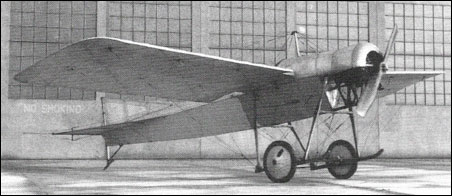|
| There is no text information for this aircraft at the moment.
| Mike Hallett, e-mail, 28.01.2011 11:45 Mike1204's comments are accurate except for the following:
"Blackburn used the Type D for a series of demonstration flights from Lofthouse Park, situated between Leeds and Wakefield, from March to May 1913. He also flew to neighbouring towns: to Stamford, dropping leaflets; to Harrogate, where he landed; and on three successive days in late July to York, carrying bundles of the Leeds-printed Yorkshire Post."
This paragraph refers to Harold Blackburn, a demonstration pilot and instructor at the Blackburn Flying School, Hendon. It does not refer to Robert Blackburn, the aircraft constructor. They were not related but were life-long friends. reply | | mike1204, e-mail, 06.06.2009 18:26 Following the Blackburn Type Es, Robert Blackburn's next design was the Single-Seat Monoplane sometimes refered to as the Blackburn Type D,and is probably his best-known of his early designs, although only a single example was built, built for Cyril Foggin in 1912, a wooden, fabric-covered single-seat monoplane, and survives at The Shuttleworth trust at Old Warden. For the first time, Blackburn fitted a rudder bar in preference to his "triple steering column".
The aircraft first flew late in 1912. Some modifications followed in time: the engine cowling was extended into a semicircular shape to discourage the discharge of smoke and hot oil from the rotary into the cockpit; the wing tips were slightly rounded; and the crook-shaped skids were replaced by ones of 'hockey stick' form.
First flown in 1912, it was powered by a 50-hp (37-kW) Gnome rotary engine and accumulated a considerable number of flying hours before it was almost destroyed in a crash of 1914. Blackburn used the Type D for a series of demonstration flights from Lofthouse Park, situated between Leeds and Wakefield, from March to May 1913. He also flew to neighbouring towns: to Stamford, dropping leaflets; to Harrogate, where he landed; and on three successive days in late July to York, carrying bundles of the Leeds-printed Yorkshire Post. Foggin sold the aircraft on to Montague Glew, who crashed it in 1914 on the family farm at Wittering, where the remains lay untouched until discovered by Richard Ormode Shuttleworth in 1938. Restoration was undertaken at Old Warden, flying again on 17 September 1947. It has the distinction of being the oldest airworthy British aircraft. reply |
|
Do you have any comments?
|
| 
COMPANY
PROFILE
All the World's Rotorcraft
|











